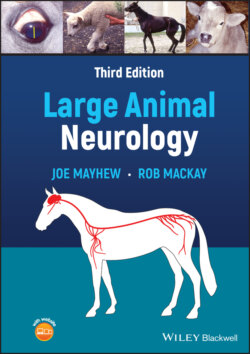Читать книгу Large Animal Neurology - Joe Mayhew - Страница 52
Final interpretation: where and what is the lesion?
ОглавлениеResults of the neurologic examination should be documented and not left to memory (Figure 2.1).
After completion of the neurologic examination, the examiner may be able to decide if and where any possible lesion exists. Sites include the basic areas of the following body components:
1 Forebrain
2 Brainstem
3 Peripheral cranial nerves
4 Cerebellum
5 Spinal cord
6 Peripheral spinal nerves and nerve roots
7 Neuromuscular junctions
8 Muscles
9 Autonomic nervous system
Often the exact location of a lesion or lesions within these divisions will be able to be defined precisely, albeit cautiously (see Figure 2.22). If the location of a lesion is not clear, then it is often worthwhile returning to the patient and performing an even more critical evaluation. Thus, if facial weakness is suspected but not clearly seen, the examiner can return to observe the horse for facial asymmetry while it is standing quietly in its stall without any stimulation. Also, a blindfold may be applied to exaggerate evidence of vestibular disease. Finally, a very fractious or a very excited horse suspected of having a degree of weakness in the limbs may be exercised before a re‐evaluation for evidence of weakness is made.
Figure 2.22 In a case of limb ataxia and weakness and based on absolute, definitive neurologic findings, the thought process at this stage of the workup may be that “All or part of the lesion(s) is between A and D.”
Any additional information that is not definitive or is ill‐defined can be used to modify the working hypothesis that the lesion is “Probably between B and C.”
This way, further scrutiny with repeated examinations and ancillary testing can be focused without losing sight of unusual, additional, or partial lesion(s).
The presence of lameness can undoubtedly interfere with the interpretation of a patient’s gait and posture, and even its behaviour. If this is suspected, then appropriate regional analgesia or the use of short acting synthetic opioid drugs (analgesics) may help to resolve the issue. With more chronic lameness cases, nonsteroidal anti‐inflammatory drugs may be given at relatively high doses for several days or weeks, and the horse’s gait can then be re‐evaluated when any confounding lameness will have been reduced or eliminated.
At some time or other, all equine clinicians will come across cases that have some indication of a morbid nervous system lesion, but no definitive proof can be obtained. Often, these cases are suspected to be suffering from conditions such as a painful musculoskeletal disorder, a neuromuscular movement disorder, a behavioral problem such as belligerency or laziness, or thoracolumbar vertebral (back) disease. Such patients may show one or more of the signs listed in Table 2.6. Examples of forms of frantic behavior have been associated with a strong suspicion of exposure to nettles or poison ants, but in these situations the signs usually abate with time. A few of these unusual syndromes are discussed in the later sections of Part II.
